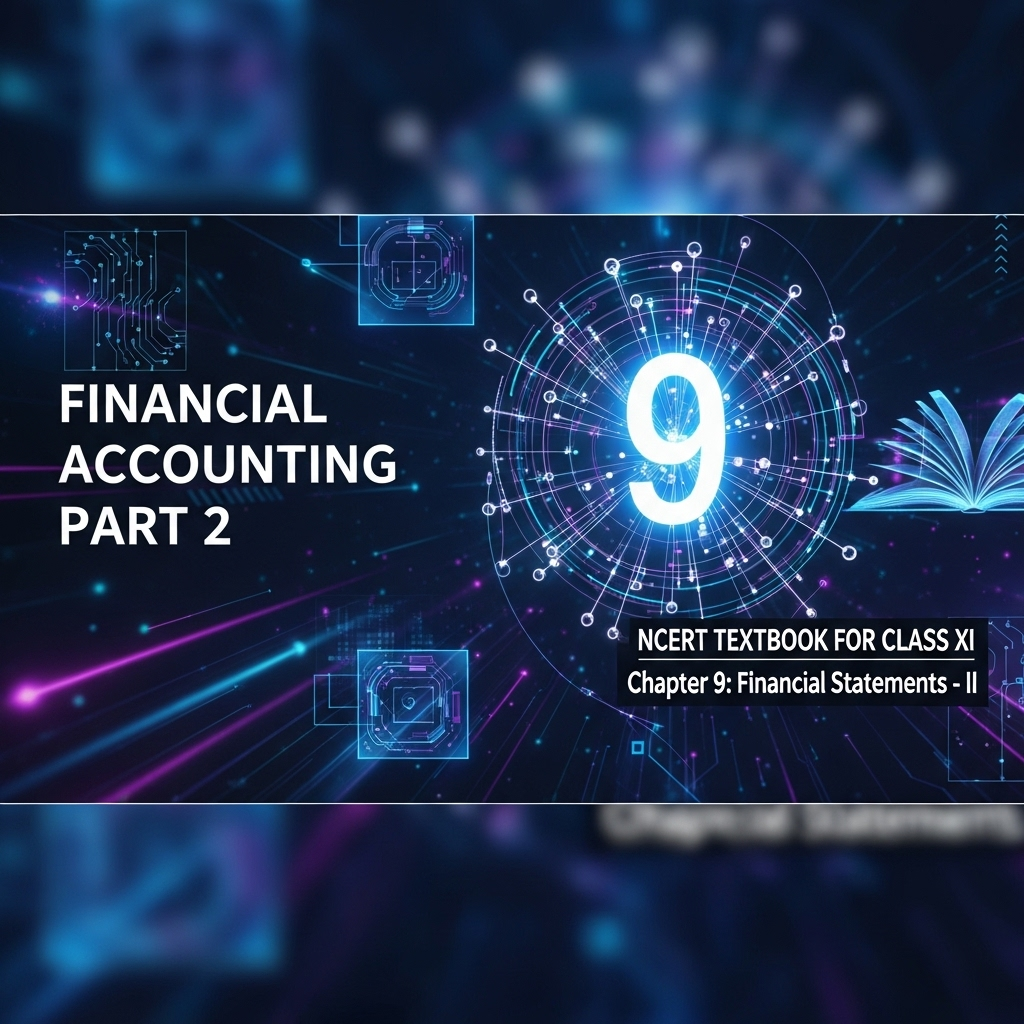Financial Statements – II – NCERT Class 11 Accountancy Financial Accounting Part II, Chapter 9 – Adjustments in Final Accounts and Practical Examples
Comprehensive coverage of adjustments needed while preparing financial statements including outstanding and prepaid expenses, accrued and advance income, depreciation, bad debts and provisions, manager’s commission, interest on capital; preparation of profit and loss account and balance sheet with adjustments illustrated through examples.
Updated: 1 month ago

Financial Statements - II
Chapter 9: Accountancy - Ultimate Study Guide | NCERT Class 11 Notes, Questions, Examples & Quiz 2025
Full Chapter Summary & Detailed Notes - Financial Statements - II Class 11 NCERT
Overview & Key Concepts
- Chapter Goal: Learn adjustments for true profit/position (accrual basis). Exam Focus: Adjust trial balance, prepare statements with items like closing stock, outstanding/prepaid expenses, accrued income, depreciation, bad debts. 2025 Updates: Emphasis on double-entry in adjustments, Ankit examples. Fun Fact: Adjustments fix "timing mismatches" like unpaid bills. Core Idea: Earned revenues, incurred expenses. Real-World: Annual audits. Ties: Builds on Ch 8 (simple statements). Expanded: Ankit trial analysis, adjustment entries, impact on P&L/BS tables.
- Wider Scope: Accrual concept drives adjustments; 11 items listed.
- Expanded Content: Need for adjustments, each item's entry/effect, Ankit reworked statements.
9.1 Need for Adjustments
Accrual basis: Revenues earned (not received), expenses incurred (not paid). Mismatches (e.g., prepaid insurance, unpaid salaries) need fixes for true view. Items: 11 adjustments (stock, expenses, incomes, depreciation, etc.). Simple Way: Like "catching up" – record what belongs to this year.
Box 1: Ankit's Trial Balance (Simple Way: Debits = Assets/Expenses, Credits = Liabilities/Revenues)
| Account Title | Elements | Debit ₹ | Credit ₹ |
|---|---|---|---|
| Cash | Asset | 1,000 | |
| Bank | Asset | 5,000 | |
| Wages | Expense | 8,000 | |
| Salaries | Expense | 25,000 | |
| Furniture | Asset | 15,000 | |
| Rent | Expense | 13,000 | |
| Debtors | Asset | 15,500 | |
| Bad Debts | Expense | 4,500 | |
| Purchases | Expense | 75,000 | |
| Capital | Equity | 12,000 | |
| Sales | Revenue | 1,25,000 | |
| Creditors | Liability | 15,000 | |
| Long-term Loan | Liability | 5,000 | |
| Commission Received | Revenue | 5,000 | |
| Total | 1,62,000 | 1,62,000 |
Additional: Closing stock ₹15,000. Simple Way: Trial is "raw data"; adjustments "polish" it.
9.2 Closing Stock
Unsold goods at year-end (cost). Adjustment: Credit Trading A/c, show as asset in BS. Entry: Closing Stock Dr. To Trading A/c. Simple Way: "What’s left unsold? Add back to profit, list as asset." Next year: Becomes opening stock.
Simple Example: Ankit (Step-by-Step)
Step 1: Without adjustment, purchases ₹75,000 + wages ₹8,000 vs sales ₹1,25,000 = Gross Profit ₹42,000. Step 2: Add closing stock ₹15,000 (credit Trading). Step 3: New Gross = ₹1,25,000 - ₹83,000 + ₹15,000 = ₹57,000. Impact: Profit up ₹15,000; BS asset up.
| Particulars | Debit ₹ | Credit ₹ |
|---|---|---|
| To Purchases | 75,000 | |
| To Wages | 8,000 | |
| To Gross Profit c/d | 57,000 | |
| Total | 1,40,000 | |
| By Sales | 1,25,000 | |
| By Closing Stock | 15,000 | |
| Total | 1,40,000 |
Alternative: Adjust via Purchases (reduce by closing, add opening) – no separate stock in Trading.
9.3 Outstanding Expenses
Unpaid expenses (e.g., wages) at year-end. Entry: Expense Dr. To Outstanding A/c (liability). Add to expense in P&L. Simple Way: "Owe money for this year? Charge it now, owe as liability." Reduces profit.
Simple Example: Ankit Wages Outstanding ₹500
Step 1: Wages paid ₹8,000. Step 2: Add outstanding ₹500 → Total wages ₹8,500 (debit Trading). Step 3: Entry: Wages Dr. 500 To Outstanding Wages 500. Impact: Profit down ₹500; BS liability up ₹500.
| Particulars | Debit ₹ | Credit ₹ |
|---|---|---|
| To Wages 8,000 | 8,000 | |
| Add: Outstanding | 500 | |
| Total Wages | 8,500 |
9.4 Prepaid Expenses
Paid in advance (e.g., salary). Entry: Prepaid Dr. To Expense A/c (asset). Deduct from expense in P&L. Simple Way: "Paid extra for next year? Save it as asset, reduce this year's cost." Increases profit.
Simple Example: Ankit Prepaid Salary ₹5,000
Step 1: Salaries paid ₹25,000. Step 2: Less prepaid ₹5,000 → Total ₹20,000 (debit P&L). Step 3: Entry: Prepaid Salary Dr. 5,000 To Salary 5,000. Impact: Profit up ₹5,000; BS asset up ₹5,000.
| Particulars | Debit ₹ | Credit ₹ |
|---|---|---|
| To Salaries 25,000 | 25,000 | |
| Less: Prepaid | (5,000) | |
| Total Salaries | 20,000 |
9.5 Accrued Income
Earned but not received (e.g., commission). Entry: Accrued Income Dr. To Income A/c. Add to income in P&L. Simple Way: "Earned but not cashed? Count as income now, asset to collect." Increases profit.
Simple Example: Ankit Accrued Commission ₹1,500
Step 1: Commission received ₹5,000. Step 2: Add accrued ₹1,500 → Total ₹6,500 (credit P&L). Step 3: Entry: Accrued Commission Dr. 1,500 To Commission 1,500. Impact: Profit up ₹1,500; BS asset up ₹1,500.
Summary
- Adjustments ensure accrual: True profit (P&L), position (BS). Ankit: Base profit ₹19,500; adjustments tweak (e.g., stock up, outstanding down).
- Double-entry: Each adjustment hits P&L/BS twice.
- Full Ankit P&L/BS: See tables in examples.
Why This Guide Stands Out
Adjustment-focused: Entries, impacts, Ankit reworked. Free 2025 with step-by-step.
Key Themes & Tips
- Aspects: Timing fixes, double-entry.
- Tip: "Earned/incurred? Adjust now." Practice Ankit full adjustments.
Exam Case Studies
Ankit adjustments, classify prepaid vs outstanding, impact on profit table.
Project & Group Ideas
- Adjust mock trial balance.
- Discuss accrual in real firms.

Group Discussions
No forum posts available.


